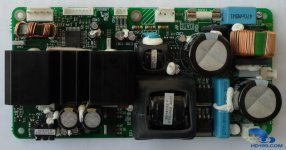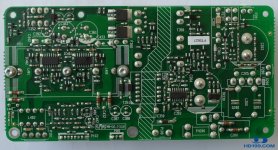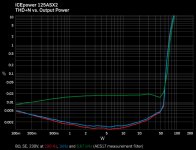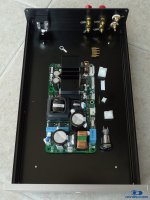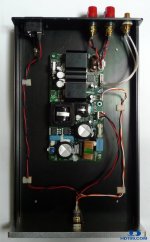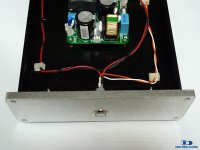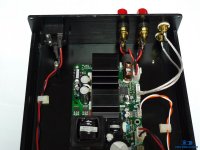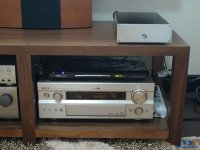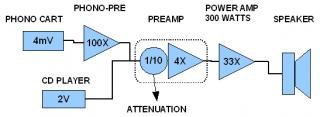I spent a month last year in Vancouver, preparing audio systems for the Olympics. Great city! I loved it.
Did Coldamp award tender in audio system of 2010 Winter Olympics which was held between February 12-28, 2010 in Vancouver, B.C. Canada? It’s great! What kind is the audio system, e.g. PA system or others? I am an experienced professional with technical background in world class large scale infrastructure project, like telecommunication, E&M, etc… Why did you not post this job reference in your website? Giant companies, such General Electric, Siemens, Schneider Electric, Philips, etc… They always post their jobs in the website when award large tendering such as Olympics, World cup, electrical power plant, railway, etc... In consumer’s viewpoint, it will increase the creditability of company. In marketing concept, it increases your product branding effect, like Apple’s iPad and iPhone.
Dear Hiropro,
The sensitivity of Focus Audio FS-888 is 90dB. Recommended power is 50~500 Watt per channel. (Ref: Inventive AV : Focus Audio FS-888) This product was launched into market around Year 2004, but stopped production now. You cannot see it in the company website.
I am not an expert in loudspeaker, just got a good one to be enough. I have heard neither the Tangband W4-1337 as a mid nor FABULOUS to use as a mid range, etc… Apart from Focus Audio in Canada and Avalon in USA, the European loudspeaker I like to be Marten Design in Sweden such as Series Bird or Miles 3. But, it is very expensive. I heard it before as it sounds excellent. You can hear a lot of detail in sound, particularly in vocal voice. The speaker drivers used is ceramic dome, may probably be from Accuton in Germany. In fact, there is huge number of loudspeaker in the market, but you can taste it all.
For your dream configuration, you changed the DAC/Pre-amplifier from Wired4Sound stuff to Audio-gd NFB-10WM. I do not comment it as it is subject to personal preference with budget cost constraint. I know this company, Audio-gd as it positions itself to be hi-end audio supplier in China. It sells products with two core technology, CAST technology used in Krell at USA and “diamond differential circuit” used in Accuphase at Japan. The rating of Audio-gd is quite good in term of Price/Performance index.
By the way, I would like to share with you about my experience with CAST technology. Apart from Class D technology, there are two common types of analog signal amplification and transmission technology. They are traditional V/I transmission and CAST technology (Ref: Krell Industries, Incorporated, America's premiere manufacturer of high-end audio equipment: award-winning amplifiers, preamplifiers, CD players, DVD players, surround/sound processors, loudspeakers) I would share with you what the theory says and what my practical experience is.
In theory, CAST technology virtually eliminates the noise and distortions created from the use of multiple voltage gain stages. Besides, CAST technology expands the usable audio signal bandwidth well over 2 MHz, ensuring harmonic reflections are virtually immeasurable in the audible frequency range. For this reason, CAST seems to be superior to traditional V/I transmission in audio application.
In practice by actual listening test, I heard the top model of amplifiers from two world class competitors, Krell using CAST and Jeff Rowland using traditional V/I transmission in two different audio shops. Both amplifiers from Krell and Jeff Rowland are world class and perform excellent in quality of sound. Personally, they perform very slightly in difference to me. As a result, I prefer to Jeff Rowland because I like its taste of sound, particularly sweet in vocal voice of sound. It is just for reference only. Even though I bring same CD into two audio shops, the CD player, loudspeaker, interconnect and speaker cables, etc… are all different. A better comparison can be made by same configuration, except the amplifier. It is an example of contradiction in theory and practical. My conclusion is that sound is so different. There is no absolute answer to the best quality of sound because it is subject to personal preference.
The sensitivity of Focus Audio FS-888 is 90dB. Recommended power is 50~500 Watt per channel. (Ref: Inventive AV : Focus Audio FS-888) This product was launched into market around Year 2004, but stopped production now. You cannot see it in the company website.
I am not an expert in loudspeaker, just got a good one to be enough. I have heard neither the Tangband W4-1337 as a mid nor FABULOUS to use as a mid range, etc… Apart from Focus Audio in Canada and Avalon in USA, the European loudspeaker I like to be Marten Design in Sweden such as Series Bird or Miles 3. But, it is very expensive. I heard it before as it sounds excellent. You can hear a lot of detail in sound, particularly in vocal voice. The speaker drivers used is ceramic dome, may probably be from Accuton in Germany. In fact, there is huge number of loudspeaker in the market, but you can taste it all.
For your dream configuration, you changed the DAC/Pre-amplifier from Wired4Sound stuff to Audio-gd NFB-10WM. I do not comment it as it is subject to personal preference with budget cost constraint. I know this company, Audio-gd as it positions itself to be hi-end audio supplier in China. It sells products with two core technology, CAST technology used in Krell at USA and “diamond differential circuit” used in Accuphase at Japan. The rating of Audio-gd is quite good in term of Price/Performance index.
By the way, I would like to share with you about my experience with CAST technology. Apart from Class D technology, there are two common types of analog signal amplification and transmission technology. They are traditional V/I transmission and CAST technology (Ref: Krell Industries, Incorporated, America's premiere manufacturer of high-end audio equipment: award-winning amplifiers, preamplifiers, CD players, DVD players, surround/sound processors, loudspeakers) I would share with you what the theory says and what my practical experience is.
In theory, CAST technology virtually eliminates the noise and distortions created from the use of multiple voltage gain stages. Besides, CAST technology expands the usable audio signal bandwidth well over 2 MHz, ensuring harmonic reflections are virtually immeasurable in the audible frequency range. For this reason, CAST seems to be superior to traditional V/I transmission in audio application.
In practice by actual listening test, I heard the top model of amplifiers from two world class competitors, Krell using CAST and Jeff Rowland using traditional V/I transmission in two different audio shops. Both amplifiers from Krell and Jeff Rowland are world class and perform excellent in quality of sound. Personally, they perform very slightly in difference to me. As a result, I prefer to Jeff Rowland because I like its taste of sound, particularly sweet in vocal voice of sound. It is just for reference only. Even though I bring same CD into two audio shops, the CD player, loudspeaker, interconnect and speaker cables, etc… are all different. A better comparison can be made by same configuration, except the amplifier. It is an example of contradiction in theory and practical. My conclusion is that sound is so different. There is no absolute answer to the best quality of sound because it is subject to personal preference.
Did Coldamp award tender in audio system of 2010 Winter Olympics which was held between February 12-28, 2010 in Vancouver, B.C. Canada?
Hi,
No, I was not there for Coldamp, we hope that our company works in events like that in the future, though!
I was working in audio broadcast systems. Let's say that all that you heard in TV or radio from the Olympics was going through several systems in which design I strongly participated.
BTW:
One of the great things about the classdaudio module is that it can be bridged.
All Class-D amplifiers that are half-bridge can be bridged if they allow for the halved load impedance ;-)
Hi,
No, I was not there for Coldamp, we hope that our company works in events like that in the future, though!
I was working in audio broadcast systems. Let's say that all that you heard in TV or radio from the Olympics was going through several systems in which design I strongly participated.
I understand that as audio broadcast system is a subsidary of large scale telecommunication infrastructure project. Although not for Coldamp, it at least shows your talent and personal capability. More chance in the future!
Yeah alant4321 I'd love to hear what other choices you have in mind. I am new to Kingwa's products. Thanks for the history lesson regarding CAST and traditional V/I designs. Current-to-voltage converter - Wikipedia, the free encyclopedia really explains it well for a layman like me LOL.
I just feel that DAC with a dale relay volume I/V conversion (stepped attenuator circuit does I/V conversion) with CAST output stage into a SDS-254 should work well no? The input on the SDS-254 is 47k and is has some kinda special "magic" balanced input stage what ever that means. Considering your understanding of the CAST stage used in Kingwa's DAC perhaps you can explain the "special" balanced input stage class d audio is using? It looks like a lot of "high end" "stages" /circuit design is used on Kingwa's DAC/Pre and the input stage on the SDS-254. I have not heard much regarding NFB-10WM other than headphone users. I'd sure love to heard from someone using the NFB-10WM for loudspeaker system. I wonder if the two would exhibit the "synergy" we are all after. The combined use of HIGH QUALITY power sections for everything including SDS-254 SMPS should really pay off.
Kingwa's NFB-10WM with CAST and special relay stepped I/V volume, Tom's IR design with "magic" balanced in, Roberto's SMPS to drive it...
hmm...
I just feel that DAC with a dale relay volume I/V conversion (stepped attenuator circuit does I/V conversion) with CAST output stage into a SDS-254 should work well no? The input on the SDS-254 is 47k and is has some kinda special "magic" balanced input stage what ever that means. Considering your understanding of the CAST stage used in Kingwa's DAC perhaps you can explain the "special" balanced input stage class d audio is using? It looks like a lot of "high end" "stages" /circuit design is used on Kingwa's DAC/Pre and the input stage on the SDS-254. I have not heard much regarding NFB-10WM other than headphone users. I'd sure love to heard from someone using the NFB-10WM for loudspeaker system. I wonder if the two would exhibit the "synergy" we are all after. The combined use of HIGH QUALITY power sections for everything including SDS-254 SMPS should really pay off.
Kingwa's NFB-10WM with CAST and special relay stepped I/V volume, Tom's IR design with "magic" balanced in, Roberto's SMPS to drive it...
hmm...
Last edited:
Hi,
No, I was not there for Coldamp, we hope that our company works in events like that in the future, though!
I was working in audio broadcast systems. Let's say that all that you heard in TV or radio from the Olympics was going through several systems in which design I strongly participated.
BTW:
All Class-D amplifiers that are half-bridge can be bridged if they allow for the halved load impedance ;-)
Yeah the SDS-254 is a half bridge topology with 2 output devices. Does this mean if you use it in bridge mode your using 4 output devices and the topology becomes full bridge 4 output device? And how does this affect pumping if it's an issue?
An externally hosted image should be here but it was not working when we last tested it.
An externally hosted image should be here but it was not working when we last tested it.
Yeah alant4321 I'd love to hear what other choices you have in mind.
Dear HiroPro,
If you would like to hear more about my choice, then I disclose that both suppliers are from Denmark, the NewClassD to be the highest price and B&O Icepower to be the lowest price in the market.
Let talk about B&O first. It is a direct communication between me and B&O Denmark, but does not involve any third party. Both technical feasibility and commercial terms are confirmed from B&O Denmark. In order to build a stereo fully balanced power amplifier with output power at 500W x2/ 8 ohm, we have two choices as below:
Option #1: Use a pair of 1-channel Icepower 1000ASP in dual mono design
Option #2: Use a pair of 2-channel Icepower 250ASX2 in bridged mode (BTL) design
Few points to share:
1) Both 1000ASP and 250ASX2 are with built-in SMPS. In other words, it is completely AC plug-to-speaker amplification audio solutions.
2) What is difference between 1000ASP and 250ASX2? Please note: 1000ASP is an old model done with discrete components while 250ASX2 is newly developed model using third generation HCOM/MECC SE amplifier topology and the amplifier stage has been ASIC integrated. In paper work data sheet, the 250ASX2 has 1/2 the distortion, 4db more dynamic range, and is 7% more efficient than the top 1000ASP. Regarding the quality of sound, both sounds excellent, but no absolute answer to be the best which is subject to personal preference. In fact, it is an endless topic to discuss which sounds better, the IC based circuit or discrete component circuit in audio amplifier?
3) I do not understand why most audio amateurs use 1000ASP, but overlook the new chip 250ASX2. The reason may be due to the fact that most commercial companies like Jeff Rowland Design Group, PS Audio, Bel Canto Design use 1000ASP. Please be reminded that they do not solely use it as AC plug-to-speaker amplification audio solution, but add component such as Lundahl by Jeff Rowland to be the technical design secret.
4) Regarding pricing, I have a complete price list, but just mention evaluation kit price and MOQ price. The unit price of 1000ASP is USD 419 (Kit) and USD 291 (MOQ at 80 pcs). The unit price of 250ASX2 is USD 299 (Kit) and USD 129 (MOQ at 240 pcs). The total cost of Option #1 is USD 838 or Euro 596 (Kit) and USD 582 or Euro 414 (MOQ). The total cost of Option #2 is USD 598 or Euro 425 (Kit) and USD 258 or Euro 183 (MOQ). Although the total cost of 250ASX2 in Euro 183 in MOQ price to be the lowest cost (i.e. minimum order quantity is 240 pcs), it prefers to use Euro 425 in Kit price for small order from audio amateurs.
5) As per B&O, 1000ASP is in stock presently, but 250ASX2 is out of stock with delivery lead-time of 6 weeks due to Japan situation.
6) As per B&O, they do not sell PWM module to individual audio amateur directly and just for commercial purpose. But they do not mention that it prohibits to be used in DIY audio industry via third party supplier. B&O is the famous brand name in the market, but with the lowest price. It is hardly to compete. I am thinking to ask which third party supplier to place sales order into B&O. My answer is Walmart which perfectly matches it. It is because Walmart’s strategy is “Everything is low price”, but it is ranked at top #1 in term of sales revenue in the world as per Fortune in 2010. Just kidding! In fact, B&O is a small company in comparing to Walmart.
Next to talk about NewClassD in Denmark. This company is not new to this Diyaudio forum. An old comparison test was done in 2008 at 2008 - Class D Amplifier comparasion test . Its reputation is better Hypex UcD, but the price also expensive than Hypex. Please note:
1) A new microprocessor controlled PWM module, NCDX-Discrete was launched at mid of 2010. The unit price is Euro 469.69, the highest in the market and expensive than the top model of Hypex UcD700HG/HxR at Euro 320.
2) The NCDX Discrete Class D modules is an one-channel PWM module which requires main input +/- 58VDC to give output power 200W per channel/ 8 ohm and up to input +/- 70 VDC to give output power 480W per channel/ 4 ohm.
3) The PWM module NCDX-Discrete claims to be the world’s lowest distortion with THD at 0.0007% from 20Hz to 20KHz. It replaces the input buffer from king of OPAMP OPA627 to self-design discrete OPAMP built with transistors and non magnetic metal film resistors for better quality of sound.
4) NewClassD does not provide SMPS. For this reason, other suppliers such as Coldamp, CAD Audio or Audio Power are available. Personally, I recommend Coldamp SMPS.
5) I am not sure whether a pair of PWM module NCDX-Discrete can be bridged to give higher power output per channel. To be confirmed from NewClassD, if yes, then Option #4 will be technical feasible by bridged mode, but more expensive.
Option #3: NewClassD (Demark): 2x one-channel NCDX-Discrete PWM module + 2x Coldamp SPS30 SMPS (Dual mono design)
=>Power output: 200W x2/ 8 ohm at cost of Euro 1,235
Option #4: NewClassD (Demark): 4x one-channel NCDX-Discrete PWM module + 2x Coldamp SPS80HV SMPS (Bridged mode design)
=>Power output: 400W x2/ 8 ohm at cost of Euro 2,245
Summary of suppliers listed in the priority of price:
1) NewClassD (Demark): 2x one-channel NCDX-Discrete PWM module + 2x Coldamp SPS30 SMPS (Dual mono design)
=>Power output: 200W x2/ 8 ohm at cost of Euro 1,235
2) Hypex UcD (Netherland): 2x one-channel UcD700HG/HxR module + 2x SMPS1200A700 (Dual mono design)
=>Power output: 375W x2/ 8 ohm at cost of Euro 1,120
3) ClassD Audio (USA): 2x two-channel SDS-258 PWM module + 2x Audio Power DPS-500S (Bridged mode design)
=>Power output: 500W x2/ 8 ohm at cost of Euro 690
4) Coldamp (Spain): 2x two-channel Sonora Combo 2S300 with built-in SMPS (Bridged mode design)
=>Power output: 500W x2/ 8 ohm at cost of Euro 626
5) Audio Power (Italy): 2x one-channel DPA-600 PWM Amplifier with built-in SMPS (Dual mono design)
=>Power output: 330W x2/ 8 ohm at cost of Euro 572
6) CAD Audio (Denmark): 2x one-channel D1000ASW PWM Amplifier with built-in SMPS (Dual mono design)
=>Power output: 500W x2/ 8 ohm at cost of Euro 460
7) B&O (Denmark): 2x two-channel Icepower 250ASX2 with built-in SMPS (Bridged mode design)
=>Power output: 500W x2/ 8 ohm at cost of Euro 425 (or even the lowest price in Euro 183 at MOQ in 240 pcs)
It is subject to individual preference. Priority is based on one of the following index:
1) Price (P) index: Low price first strategy
2) Price/Performance (P/P’) index: A balance between price and performance in quality of sound
3) Performance in quality of sound (P’) index: The highest quality of sound first strategy
The economic model of consumer electronic audio industry is under a perfectly competition market and consumer has an absolute bargaining power to any audio supplier. In other words, there are a lot of competitors in the market and consumer has a lot of choice. Due to technology requirement, the market entry barrier into PWM supplier for DIY audio market is high. For this reason, the increase of competitor is relatively slow. However, the pricing of PWM module will be at a self-regulated policy under perfectly competition situation.
I have a dual Master degree in both computer engineering and business in the same world class university which is ranked at top #1 in the region and within top #30 in the world as per QS World University ranking 2010. My concept of global business is: A company cannot grow without advanced technology support (Technology driven). But the most important is that a company cannot make profit without practical experience to meet customer satisfaction (Marketing oriented). In other words, an audio amateur make DIY as per personal preference. But, an audio designer builds product innovation not only as per specification, but also the tolerance to meet customer satisfaction.
Concept: Trend of global business: Technology driven + Marketing oriented = Sure win in the market, may probably to be the market leader
I just feel that DAC with a dale relay volume I/V conversion (stepped attenuator circuit does I/V conversion) with CAST output stage into a SDS-254 should work well no? The input on the SDS-254 is 47k and is has some kinda special "magic" balanced input stage what ever that means. Considering your understanding of the CAST stage used in Kingwa's DAC perhaps you can explain the "special" balanced input stage class d audio is using? It looks like a lot of "high end" "stages" /circuit design is used on Kingwa's DAC/Pre and the input stage on the SDS-254. I have not heard much regarding NFB-10WM other than headphone users. I'd sure love to heard from someone using the NFB-10WM for loudspeaker system. I wonder if the two would exhibit the "synergy" we are all after. The combined use of HIGH QUALITY power sections for everything including SDS-254 SMPS should really pay off.
Kingwa's NFB-10WM with CAST and special relay stepped I/V volume, Tom's IR design with "magic" balanced in, Roberto's SMPS to drive it...
hmm...
Dear HiroPro,
First of all, I recommend you to define clearly about your goal in selection criteria. The goal tells you about what taste of sound you like and the functionality required under budget constraint. Please note typical structure of DAC/ Pre-amplifier as below:
DAC:
1) Digital signal receiver
2) Digital filter
3) Digital to Analog Conversion (DAC)
4) Output stage by analog signal amplification
Pre-amplifier:
5) Signal selector (Select input channel by relay which controlled by MCU)
6) Volume adjustment (Select sound level by relay and resistor controlled by MCU)
7) Output stage by analog signal amplification (e.g. standard 10x)
I have no time to review Kingwa's NFB-10WM. But, you need to answer yourself about the captioned #1 to #7. Please note:
1) Stage #1 to #3 determines the accuracy of digital signal transmission. Since you use PC as digital source and there is no USB input in NFB-10WM, you need a USB to digital coaxial RCA converter.
2) Dale 1% precision is OK in stepped attenuator circuit. Stage #5 to #6 basically does not affect the quality of sound.
3) The most important and critical process is stage #4 and #7 which seriously affects the quality of sound. The effect of sound depends on:
=> The material used for components of resistor, capacitor and transistor (i.e. OPAMP is not used)
=> The topology of circuit design (i.e. Is it to be the traditional I/V or CAST?)
The last question is the interface requirement between the pre-amplifier and class D power amplifier. Good luck!
Nice recap alant..!
When evaluating the options it would be nice to put the technical details into the picture and not just subjective reports.
For example, I have been extremely happy with the sound I get from my Truepath (Tripath 3020-based) power amp but its loudspeaker-dependent frequency response deviations certainly irritate my technical side..
I know it's wrong, even if subjectively the amp sounds fine. Simple as that.
That and the fact that I'd rather have monoblocks next to my speakers are the main reasons I'm thinking of upgrading to Hypex or Audiopower amps.
When evaluating the options it would be nice to put the technical details into the picture and not just subjective reports.
For example, I have been extremely happy with the sound I get from my Truepath (Tripath 3020-based) power amp but its loudspeaker-dependent frequency response deviations certainly irritate my technical side..
I know it's wrong, even if subjectively the amp sounds fine. Simple as that.
That and the fact that I'd rather have monoblocks next to my speakers are the main reasons I'm thinking of upgrading to Hypex or Audiopower amps.
Last edited:
Well... all I know is I wouldn't want the PSU to be apart of the amp PCB! I don't like the idea of being stuck with one option. What if I want to try a huge linear or a SMPS and try different caps etc! As for the other three amps, I've heard B&O ICEpower before and it sound great but I feel it's such a common solution and just about all the ICEpower model's I've heard sound the same. Outside the input stage they are all just about the same no? So basically they are gainclones in the sense that they all sound about the same less the input stage colourization and without the gainclone mod/hackability. As for that Danish amp... looks interesting with the microprocessor and LCD. I can see the Danish unit is the most expense but I can't see how the ICEpower modules are cheaper than Tom's IR solution.
Personally if I had the coin the BOM for me is SDS-254 bridged at 500W with two DPS-500/S PSUs. Considering what some pay to go pure DC or AC filtering etc I feel the extra cost of that PSU is warranted as I feel it should be as clean as DC-DC or some expensive AC filtering option.
This is all speculation but I feel those components for a budget minded person like me would work great.
The NFB-10WM does have USB-->I2S-->WM8741 though I doubt it's as good as... say the HI bridge with TAS1020B and the Streamlength™ code. Thing is... I could buy an HI bridge later and take advantage of Gordon Rankin's TAS1020B firmware/microcode work.
I would like to know more about the SDS-254's balance input stage and how well it would work with the NFB-10WM output. The other great thing about the SDS-254 is the gain pot. You could dial it in pull it off take a reading and make a molex jumper with right values soldered into the molex to avoid pot affects etc and simply plug into molex for desired gain structure. You could dial in the gain structure easily then and avoid the gain pot.
PC-->HI SP/DIF bridge-->NFB-10WM-->SDS-254 bridged with dedicated DPS-500-S per module.
I think the use of the NFB-10WM as a pre considering my transport is PC only would work fantastic because I don't need input switching I/O standalone pre. The short signal path, use of CAST and that special I/V relay volume, Kingwa's dac multi PSU, Audio Power's special SMPS with SDS-254's special balanced in... dying to hear such a solution!!!
I'd like to know more about the SDS-254's balanced input stage. What is the "magic circuit"? I think that's what it's called...
Personally if I had the coin the BOM for me is SDS-254 bridged at 500W with two DPS-500/S PSUs. Considering what some pay to go pure DC or AC filtering etc I feel the extra cost of that PSU is warranted as I feel it should be as clean as DC-DC or some expensive AC filtering option.
This is all speculation but I feel those components for a budget minded person like me would work great.
The NFB-10WM does have USB-->I2S-->WM8741 though I doubt it's as good as... say the HI bridge with TAS1020B and the Streamlength™ code. Thing is... I could buy an HI bridge later and take advantage of Gordon Rankin's TAS1020B firmware/microcode work.
I would like to know more about the SDS-254's balance input stage and how well it would work with the NFB-10WM output. The other great thing about the SDS-254 is the gain pot. You could dial it in pull it off take a reading and make a molex jumper with right values soldered into the molex to avoid pot affects etc and simply plug into molex for desired gain structure. You could dial in the gain structure easily then and avoid the gain pot.
PC-->HI SP/DIF bridge-->NFB-10WM-->SDS-254 bridged with dedicated DPS-500-S per module.
I think the use of the NFB-10WM as a pre considering my transport is PC only would work fantastic because I don't need input switching I/O standalone pre. The short signal path, use of CAST and that special I/V relay volume, Kingwa's dac multi PSU, Audio Power's special SMPS with SDS-254's special balanced in... dying to hear such a solution!!!
I'd like to know more about the SDS-254's balanced input stage. What is the "magic circuit"? I think that's what it's called...
Last edited:
$175 Class D amp--120 wpc
Post 2451 was using Icepower 1000 and switched to SDS-258 half bridge and feels it's better than Icepower 1000. I can imagine SDS-254 bridge with DPS-500-S would be that much better.
Post 2451 was using Icepower 1000 and switched to SDS-258 half bridge and feels it's better than Icepower 1000. I can imagine SDS-254 bridge with DPS-500-S would be that much better.
Last edited:
$175 Class D amp--120 wpc
Post 2451 was using Icepower 1000 and switched to SDS-258 half bridge and feels it's better than Icepower 1000. I can imagine SDS-254 bridge with DPS-500-S would be that much better.
Dear HiroPro,
Under user paid principle, it is subject to your personal preference. I totally respect to your decision though it may not be my final decision.
Just for your reference!
As per my thread #29, the B&O Icepower 250ASX2 is recommended. Searching over internet yesterday, I found a practical experience in actual listening test sharing of Icepower 125ASX2 done by a Chinese DIY forum at ÖÆ×÷ ICEpower ºó¼¶¹¦·Å£¬¼æ³¶³¶¹¦·ÅÄÇЩµ° - ¡ò¼ÒÍ¥Ó°ÔºÒôƵ - ¼ÒÍ¥Ó°ÔºÒôÏìÖ÷ÌâÍø -¹¦·Å|ÒôÏä|ͶӰ|HiFi|3D|µçÓ°|ÒôÀÖ|CD|DVD|BD|HDMI|À¶¹â|¸ßÇå|´ÎÊÀ´ú - Powered by Ó°ÒôÐÂʱ´ú|hd199.com . The original message is written in Chinese, but you can use any “internet translator” to translate into English. The comment is done by the Administrator of the Chinese DIY forum as follow: “How does the sound quality of Icepower 125ASX2 perform? I just say that the sound is relatively thick, full band and on balance. It is a relatively neutral sound and impressive is the kind of leisurely. I cannot tell you any shortcomings. Just one word: stability.”
My comment for Icepower 250ASX2 was finalized as per thread #29 on 30-Mar-2011. The comment of 125ASX2 from the Chinese DIY forum was released on 3-Apr-2011 which was 4 days after my comments. Previously, I just guess. But, I believe that my approach is correct now.
How does class D perform in comparing to class AB power amplifier? Last week, I attended an actual listening testing in an audio shop to compare the following two options:
Option #1: Jeff Rowland Continuun 500 class D integrated amplifier (about Euro 6,300)
Option #2: Jeff Rowland Corus pre-amplifier and new model of #625 class AB power amplifier using SMPS and 12 pairs of JP Sanken STD03N/STD03P Bi-polar transistor. (total cost about Euro 17,900)
My comment: I have no golden ear. Personally, Option #2 of class AB actually performed in superior to Option #1 of class D, but the difference of sound quality is not significant to pay additional price of Euro 11,600 to select class AB. In conclusion, class D module is now well developed to suit to hi-end audio application and the sound quality is highly competitive to class AB. Please throw away your old concept that class D is only suitable for car audio and PA system. The future trend of audio amplifier will migrate to class D with advantages of high power, compact size, lower cost, energy saving, etc... However, individual audio amatuers can pay additional cost to select their own toys.
Please see some photos of B&O Icepower 125ASX2 as below:
As per my thread #29, the B&O Icepower 250ASX2 is recommended. Searching over internet yesterday, I found a practical experience in actual listening test sharing of Icepower 125ASX2 done by a Chinese DIY forum at ÖÆ×÷ ICEpower ºó¼¶¹¦·Å£¬¼æ³¶³¶¹¦·ÅÄÇЩµ° - ¡ò¼ÒÍ¥Ó°ÔºÒôƵ - ¼ÒÍ¥Ó°ÔºÒôÏìÖ÷ÌâÍø -¹¦·Å|ÒôÏä|ͶӰ|HiFi|3D|µçÓ°|ÒôÀÖ|CD|DVD|BD|HDMI|À¶¹â|¸ßÇå|´ÎÊÀ´ú - Powered by Ó°ÒôÐÂʱ´ú|hd199.com . The original message is written in Chinese, but you can use any “internet translator” to translate into English. The comment is done by the Administrator of the Chinese DIY forum as follow: “How does the sound quality of Icepower 125ASX2 perform? I just say that the sound is relatively thick, full band and on balance. It is a relatively neutral sound and impressive is the kind of leisurely. I cannot tell you any shortcomings. Just one word: stability.”
My comment for Icepower 250ASX2 was finalized as per thread #29 on 30-Mar-2011. The comment of 125ASX2 from the Chinese DIY forum was released on 3-Apr-2011 which was 4 days after my comments. Previously, I just guess. But, I believe that my approach is correct now.
How does class D perform in comparing to class AB power amplifier? Last week, I attended an actual listening testing in an audio shop to compare the following two options:
Option #1: Jeff Rowland Continuun 500 class D integrated amplifier (about Euro 6,300)
Option #2: Jeff Rowland Corus pre-amplifier and new model of #625 class AB power amplifier using SMPS and 12 pairs of JP Sanken STD03N/STD03P Bi-polar transistor. (total cost about Euro 17,900)
My comment: I have no golden ear. Personally, Option #2 of class AB actually performed in superior to Option #1 of class D, but the difference of sound quality is not significant to pay additional price of Euro 11,600 to select class AB. In conclusion, class D module is now well developed to suit to hi-end audio application and the sound quality is highly competitive to class AB. Please throw away your old concept that class D is only suitable for car audio and PA system. The future trend of audio amplifier will migrate to class D with advantages of high power, compact size, lower cost, energy saving, etc... However, individual audio amatuers can pay additional cost to select their own toys.
Please see some photos of B&O Icepower 125ASX2 as below:
Attachments
Today, I read a good article “What is gain structure?” written by Michael Mardis in Diyaudio at http://i.diyaudio.com/display.php?M=136791&C=b333c0e7f68fd1a5f36b319b275263e2&S=81&L=3&N=51 . Just for reference!
Please see the photo below of “Typical gain structure of a home audio system”
Please see the photo below of “Typical gain structure of a home audio system”
Attachments
...
For example, I have been extremely happy with the sound I get from my Truepath (Tripath 3020-based) power amp but its loudspeaker-dependent frequency response deviations certainly irritate my technical side..
I know it's wrong, even if subjectively the amp sounds fine. Simple as that.
...
Is this a dedicated problem of the truepath or a general problem of tripath amps?
I'm afraid that's how Tripath amps work...
Indeed that might be an issue. But an issue which should be easily possible to be corrected digitally (if digital correction is part of your system anyway). Much more serious would be a load-dependent frequency response - I guess ...
- Status
- This old topic is closed. If you want to reopen this topic, contact a moderator using the "Report Post" button.
- Home
- Amplifiers
- Class D
- Enquiry about DIY Class D power amplifier
